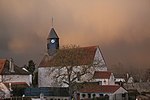École nationale supérieure d'informatique pour l'industrie et l'entreprise
The École nationale supérieure d'informatique pour l'industrie et l'entreprise (ENSIIE) (National School of Computer Science for Industry and Business), formerly known as Institut d'informatique d'entreprise, is a French public grandes écoles specialising in computer science and applied mathematics. Students can be admitted to ENSIIE through the selective Concours Mines-Télécom examination, after a strong competition during two years of undergraduate studies in classes préparatoires aux grandes écoles. The selection was done on the Concours Centrale-Supélec examination before 2015. Students can also be admitted through parallel admissions, coming from various IUT as well as multiplie faculties all around France, along with a number of international students through partnerships. The school belongs to prestigious groups of institutions such as Institut Mines-Télécom, or University of Paris-Saclay (associate member).The ENSIIE Engineering School was created by the Conservatoire National des Arts et Métiers in 1968. Initially located in Paris, it is now in Évry (France). In 2020, the ENSIIE benefits from a network of over 4000 Alumni, engineer who have graduated from the school under any major or type of training.
Excerpt from the Wikipedia article École nationale supérieure d'informatique pour l'industrie et l'entreprise (License: CC BY-SA 3.0, Authors).École nationale supérieure d'informatique pour l'industrie et l'entreprise
Desserte des Passages, Évry
Geographical coordinates (GPS) Address Nearby Places Show on map
Geographical coordinates (GPS)
| Latitude | Longitude |
|---|---|
| N 48.626725 ° | E 2.431905 ° |
Address
Desserte des Passages
Desserte des Passages
91000 Évry
Ile-de-France, France
Open on Google Maps








